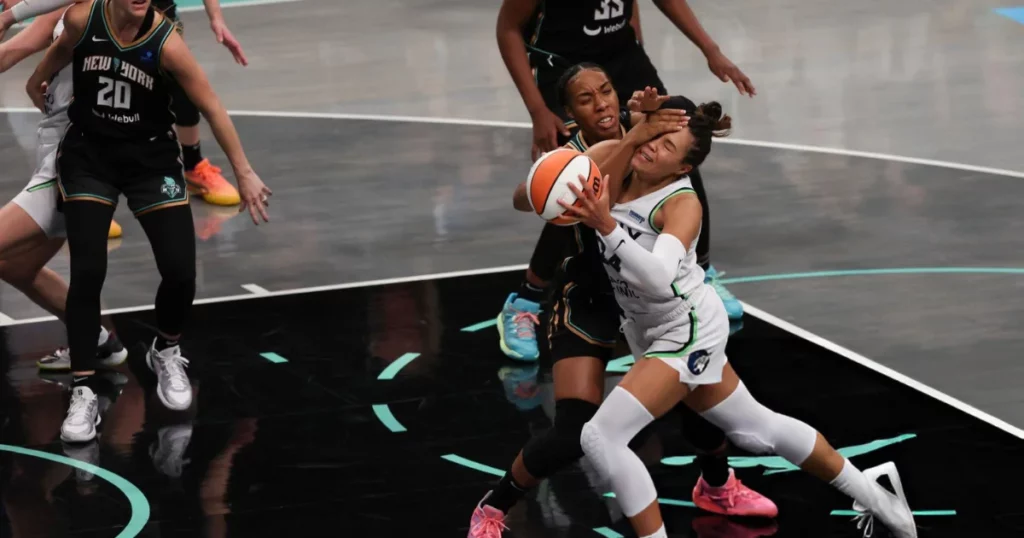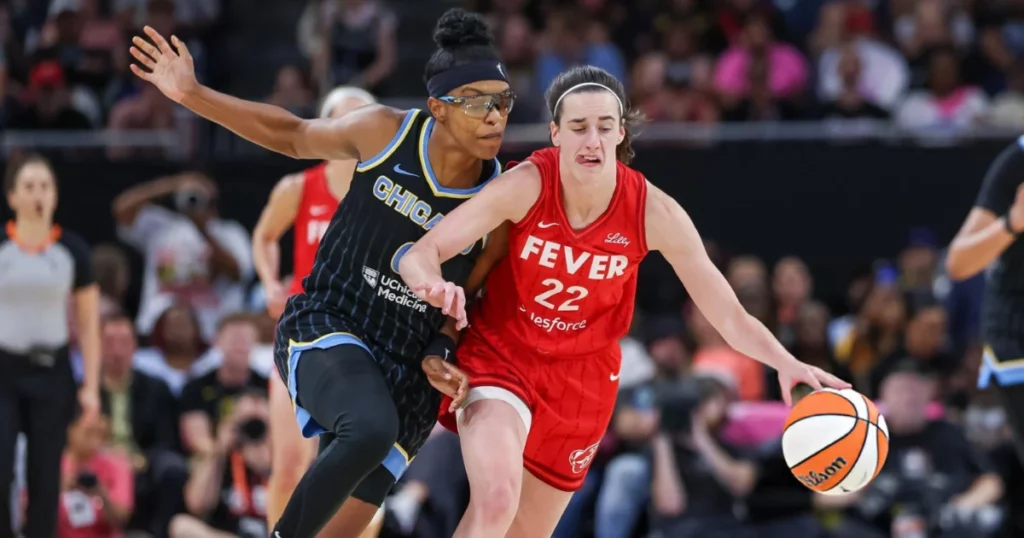How many fouls to foul out in the WNBA?
Fouls in basketball play a significant role in player performance and team strategy. Knowing the number of fouls needed to be fouled out in WNBA basketball is essential for players, coaches, and fans. In this article, we shall discuss the particularities of WNBA foul regulations, including personal fouls, technical fouls, and flagrant fouls, and how they affect the course of the game.
What Counts as a Personal Foul?

A personal foul is said to take place when a player commits unlawful physical contact with another player. For example, in the context of the WNBA, if a player makes illegal contact with an opposing player, it will be termed a ‘physical foul.’ Such types of fouls are committed by the players in the league under certain consequences.
- Blocking an opponent’s path in an unethical manner.
- To grab or hold a player on the court
- Pushing or hitting an opponent while they are shooting.
Every mistake from an individual counts for the total foul count of a player for that particular game or match. The WNBA has rules about the maximum number of six personal fouls that can be committed before disqualification from the game. This rule helps athletes maintain decent behavior and perfect competition.
In this context, fouling out refers to leaving the game and not coming back again. Such limitations considerably affect the rotation and strategies of the team. It’s the same when a crucial player missing the game affects the support of the home team fans and their support. At the same time, it puts pressure on other players to step up into that void.
Impact of Fouling Out on Team Strategy
However, eventually, if a player is fouled out, the coach has to tweak the lineup and deal with a more conservative defensive game. Most of the time, the teams are expected to get susceptible when it is a key player who gets early fouls and thus substituted to keep substituting ready for the big moments, which might even lead to more actual time on the floor for bench players who will have to learn how to step up under pressure to keep the team competitive.
Some teams might adjust their defense tactically and may adopt a zone defense to lessen direct physical contact or assign their most disciplined defenders to mark the leading scorers of the opposing team. These changes explain the dynamic nature of basketball tactics and the extent to which foul management could impact play.
General WNBA Foul Rules and Their Importance
How Many Fouls Are Allowed in the WNBA?
In the WNBA, a player is allowed six personal fouls before they are disqualified, or “foul out.” This differs slightly from the NBA, where players are permitted five personal fouls. Understanding this distinction is crucial for players transitioning between leagues or fans comparing the two formats.
Foul Strategies: How Players Adapt
Players often adapt their playing style based on foul situations. For example:
- Aggressive Defense: Players with fewer fouls may take on challenging defensive assignments, applying pressure to disrupt the opponent’s rhythm.
- Avoiding Risk: Players in foul trouble tend to play less aggressively to avoid disqualification, sometimes conceding easy baskets rather than risking a foul.
Coaches also strategically manage minutes to minimize the risk of fouling out. Rotations are designed to give players a break when they’re nearing their foul limit, ensuring they can contribute during the game’s critical stages. In high-stakes games, this balance becomes even more delicate, as every possession and player availability can vary the outcome.
How Many Technical Fouls Before Suspension in the WNBA?
Defining Technical Fouls

A technical foul is charged for the lack of unethical behavior in the context of sportsmanship, which includes:
- Arguing with referees.
- Gestures or language that defy the ethics of Sportsmanship
- Delay of game violations.
Technical fouls have a more specific scope than personal fouls, having to do with behaviors and not actions on the court. Therefore, the technical foul is a more precise indication of an athlete’s emotional control and her ability to keep herself composed throughout the game.
When Do Technical Fouls Result in Suspension?
In the Women’s National Basketball Association, two technical fouls in a single game will lead to automatic ejection. Furthermore, the total accumulation of seven technical fouls during the entire regular season would equate to a one-game suspension. Every additional technical foul carries its penalty of suspension, so this means how crucial keeping himself composed in the game is to every player. Such an understanding may promote more professionalism among players and keep the game away from disputes in athletic competition.
Athletes and trainers need to know these limits and especially in matches or playoff series, when emotional reactions may be more likely. Most teams often designate their team captains to represent their teams and interact with referees. For this reason, there are reduced chances that technical fouls occur as a result of disputes.
How Many Flagrant Fouls in the WNBA?
What Qualifies as a Flagrant Foul?

A flagrant foul is a severe form of foul involving excessive or dangerous contact. These fouls are categorized into two types:
- Flagrant 1: Unnecessary contact, such as hard fouls during a shot attempt.
- Flagrant 2: Excessive and dangerous contact that shows malicious intent, often leading to ejection.
Flagrant fouls are subject to video review by referees, ensuring accurate decisions and maintaining player safety. It is a process that has been made keeping in mind the prestige of maintaining fairness and integrity in the league about the rules.
Examples of Past Flagrant Fouls in WNBA History
- In 2017 there was a serious offensive foul in the WNBA Finals; Lindsay Whalen caught Odyssey Sims pretty hard from one of the flares, and it caused suspension that led to changing the outcome of the series. This just proves the fact that discipline has to be part of such important games.
- In 2024, it became news when Alyssa Thomas was slapped with a foul for her Flagrant 2 against rookie Angel Reese, raising the inevitable talking point: How consistent is the officiating, and how subjective can one interpret the flagrant foul calls?
Impact on Game Outcomes and Player Reputation
Flagrant fouls not only impact the immediate game but also affect player reputations. Repeat offenders risk suspension, fines, and potential damage to their professional image. Players known for excessive fouls may face scrutiny from officials, opponents, and even their teams, influencing their playing opportunities and contract negotiations.
Flagrant and Technical Fouls: How the WNBA Protects Players
The WNBA Rulebook does have much more stringent rules directed towards the technical and flagrant fouls for protecting the players and the game itself. The table below outlines the most important differences:
| Aspect | Flagrant Foul | Technical Foul |
|---|---|---|
| Definition | Excessive or dangerous contact | Unsportsmanlike behavior |
| Types | Flagrant 1, Flagrant 2 | Single type |
| Penalty | Free throws + possession change | Free throw for opposing team |
| Ejection | Possible for Flagrant 2 | Automatic after two in one game |
| Suspension Threshold | Multiple flagrant fouls in a season | Seven technical fouls in a season |
These laws preserve fair competition and discourage irresponsible or unsportsmanlike conduct; thus, they achieve a proper balance between competitive spirit and safety. By distinguishing between significant and technical fouls and putting emphasis on the disciplinary aspect, the WNBA promotes a spirit of competition but not the absence of respect.
Conclusion
Understanding foul regulations in the WNBA—personal, technical, and flagrant fouls’ definition—is crucial in appreciating the strategy and discipline inherent in the game. Judging personal contact with one’s opponent called foul makes it important for athletes to balance aggression versus caution to remain on their feet in the game, the downside being possible suspension for fouling out in competition, as coaches schedule their rotation strategically in favor of better performance. Ultimately, the rules create an environment that is competitive but safe and keeps the integrity of the game.
Key Takeaways:
- The WNBA regulations stipulate that players can accumulate six personal fouls, which will disqualify an individual from a game. This essentially enforces the requirement of disciplined physical and defensive play.
- Accumulating seven technical fouls in one particular season leads to the suspension of the player. This indicates the importance of emotional control.
- Flagrant fouls come in two degrees, which involve rather severe penalties for cases of gross physical contact, thus emphasizing the safety of players.
- These laws concerning fouls determine the dynamics of the games and the safety of the players, as these serve fundamental functions in the organization and rhythm of professional basketball itself.
FAQs
Q. How many personal fouls can a player get in the WNBA?
A. A player can receive five personal fouls in a WNBA game before being disqualified or “fouled out”.
Q. Can a player get ejected for a technical foul in the WNBA?
A. Yes, a player can be ejected from a WNBA game for receiving two technical fouls.
Q. How many flagrant fouls can a player commit before being ejected?
A. In the WNBA, a player is automatically ejected after committing two flagrant fouls in the same game.
Q. Do technical fouls lead to suspension in the WNBA?
A. Under WNBA rules, a player or coach is automatically suspended without pay for one game upon receiving a seventh technical foul during the regular season, as per WNBA.
Q. How do fouls impact team strategy in the WNBA?
A. A big part of how a team may strategize is based on fouls in the WNBA. It can change the function of each player and also the overall impact of his role in a particular slot of the game.
